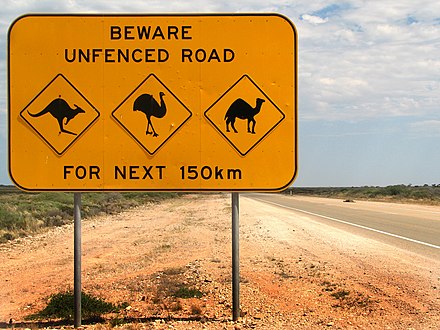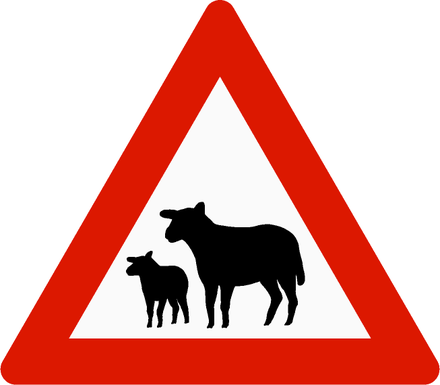Animal collisions, also called roadkill, are a major risk in driving. A head-on collision with a large animal such as moose or cattle is certain to cause human injuries and vehicle damage. And in any case, animal collisions threaten wildlife and livestock. Drivers are in most countries obliged to stop and call relevant authorities (typically the police) for instance to kill and dispose of injured animals.
Risk factors

- Times when many large animals are on the move:
- Sunrise and sunset; also has a blinding effect on drivers and animals
- Rainfall; also impairs sight and braking
- Mating and hunting seasons; seasonal moves between regions
- When the young are starting an independent life
- Full moon and/or heavy snowfall (elk/moose in particular)
- Cold weather; makes animals look for food near human settlements, winter driving also poses other risks
- Plowed roads; which make animals prefer the road for movement, and to eat salt from the ground
- Places where large animals tend to be on the move
- Bodies of water
- Bridges; animals might use bridges for convenience, and might lose orientation on them
- The edge of forests
- The edge of wildlife fences
- Farms; not only pets and livestock, but also wild animals intruding into crops
- Livestock in pastures
- Other warning signs
- Farmworkers or farming vehicles might lead livestock behind them
- When you see one animal, others are probably nearby
- Livestock enclosures, or facilities like stables may indicate the potential animals in the vicinity.
- Fog. Reduces sight both for vehicles and animals
Precautions
Keep a keen eye on the forest edge. Often the animals stay there for some time, hard to notice for an untrained eye, before entering the road.
Use headlights and seatbelts. Be well-rested behind the wheel. Adapt speed to daylight and rainfall.
Using whistles attached to your vehicle to make a high-pitched noise can help to alert wildlife of your approach on the road in rural high-risk areas. The effect has not been proven, though.
A car horn might scare animals. Only use them from far distance.
Travellers might be tempted to steal warning signs as souvenirs, especially for animals they perceive as exotic. This is not only illegal; it also increases the risk for animal collisions. In some places equivalent boards can be purchased instead, perhaps made into tables or in more convenient sizes.
Many birds are able to avoid cars coming in 80 km/h, but not those driving 90 km/h. One more reason to avoid speeding. There are often insects here, luring small birds into the danger. Other birds (and mammals) may come for the carcasses from earlier collisions. If safe to do so, you might want to move such carcasses off the road.
Reaction
If you are forced to hit an animal, the rear end of deer and many other large animals is less heavy than its front. Trying to steer behind the animal also gives it a chance to run away forwards – something it will probably try also if you steer in front of it.
Do not relax having avoided the animal you saw: it probably has company. Do not rely on the animals behaving rationally; drive slow until securely past all of the herd.
After the accident
In some jurisdictions, you are supposed to report animal collisions, be it with working animals, livestock, or wildlife, so check procedures beforehand. You might be asked to mark the place (with a red flag or similar) so that hunters can find a wounded animal. GPS coordinates or a trip meter distance to a known place can help locating the site. For small animals you might want to end the suffering yourself. Do not try to kill an animal unless you know how, and do not search for an animal that has run away (it will try to flee, suffer more and be harder to find later).
For domestic animals, the decision about whether to try to save its life should in most cases be left to a veterinarian. A wounded animal will in most cases be very scared and will probably not appreciate attempts to comfort it; a dog may bite.
Some animals are very dangerous when wounded. Bears are often cited for this, but a boar is probably the worst: it may hide in the vegetation and charge with its tusks when you are in reach, inflicting critical damage. Even if armed you are no match at short distance. Stay in the car. The marking can be placed 100 m from the collision site, remember to tell you did it that way.
Australia
.jpg/440px-Wallaby_%26_Joey_(7988301559).jpg)
Australia has many marsupials (mammals with pouches, such as kangaroos, koalas and wombats) on country roads, and often get involved in collisions. A dead animal may still have a 'joey' (baby marsupial) alive in its pouch. It is worth checking if safe for you to do so.
Nordic countries
Collisions with elk and deer are relatively common in Finland and Scandinavia. You are required to report collisions with big game (to the police or 112), even if the animal is not obviously hurt. You should mark the place, so that hunters with dogs can take care of it.
